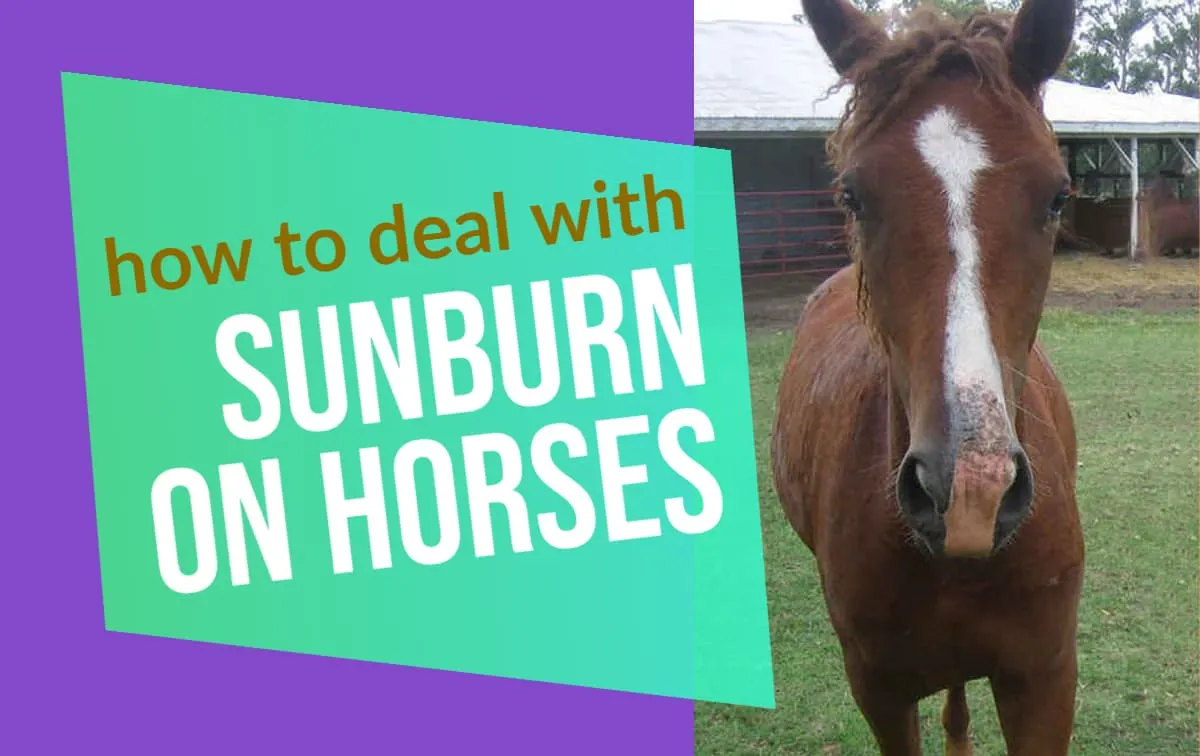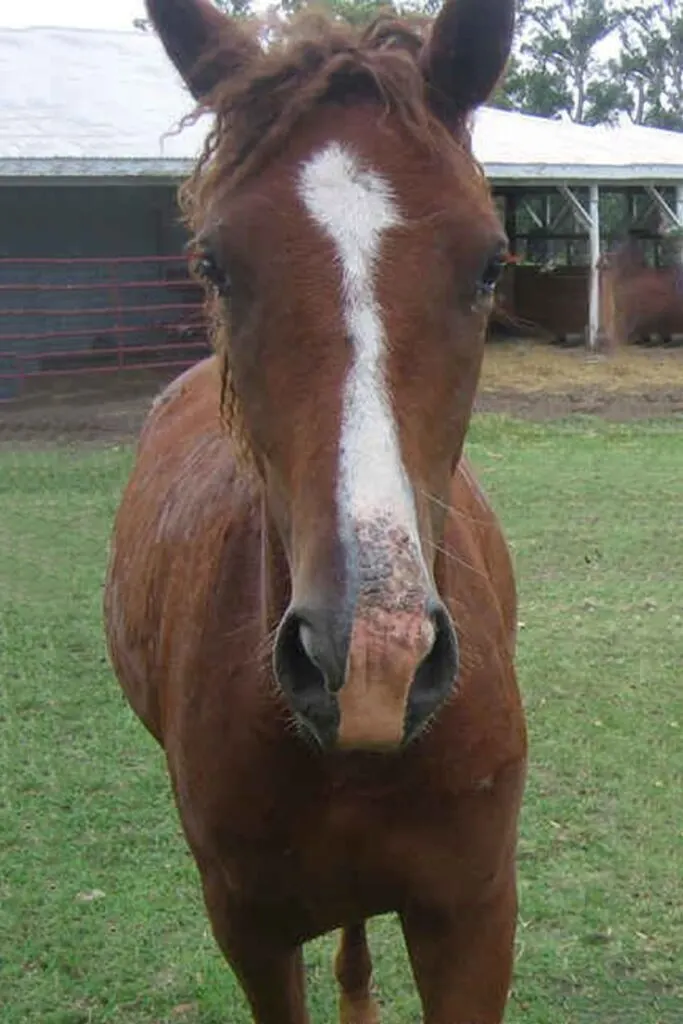Many people are surprised to learn that horses, like people, can sunburn. Despite the fact that many horse breeds evolved in hot, sunny regions it is still possible for horses to sunburn as they graze in sunny pastures during the spring and summer. Sunburn is also possible- potentially even more likely, for horses when they are turned out in snowy pastures. Light reflecting off of snow can reflect UV rays onto more sensitive skin than direct sunlight typically reaches.
Some horses, due to color, skin type, or health condition, are more sensitive to the sun than others and can sunburn easily. Paint and pinto horses, which can have large areas of white fur and pink skin are most susceptible, but any horse with pink skin can potentially sunburn. According to Kentucky equine research horses are most likely to get sunburns when spending long periods outdoors during the spring and early summer. This heightened risk of sunburn at the beginning of summer is due to winter coats shedding and the thin (and perhaps not fully grown-in) summer coats leaving sensitive skin exposed to UV light from the sun.

Below, I’ve listed a few of the methods we use to deal with and treat sunburns on horses, Keep in mind that just like people, cumulative sunburns can be harmful to the skin long term. To prevent burning the same sensitive skin over and over, apply sunscreen before day turnout or stable your horse in a stall or shady corral during the hottest and sunniest portions of bright summer days.
The following section may contain affiliate links. As an Amazon Associate, we earn from qualifying purchases.
Horse Sunburn Treatment
The treatment for a sunburned horse is similar to that of the sunburn treatment for humans: while the horse’s sunburn is healing, frequent applications of pure aloe vera gel can soothe the sunburned horse’s skin immensely. If a horse has a mild sunburn near an eye, it’s best to not apply the sunburn treatment and allow nature to run its course rather than risk introducing infection through a non-sterile treatment. If a horse has a severe sunburn near an eye or eyelid, it’s best to contact your veterinarian. After your horse’s sunburn has healed you’ll want to consider ways to prevent sunburn in the future.
Photo of a Horse Sunburn: What It Looks Like:

What does a Sunburn on a Horse look Like?
Severe sunburns on horses are not difficult to recognize. A horse’s sunburn may appear as inflamed skin on the muzzle, tail, ear tips, or anywhere the skin is light-colored and the horse’s coat isn’t thick enough to protect the skin. As the sunburn heals it may develop scabs or flake off. In intense direct sunlight, horses with pink skin may even sunburn on their back.
You can tell the difference between non-sunburn-related skin irritation and sunburns best by noticing where the sunburn is on the horse’s body. If the skin that is inflamed and irritated is only on light-colored skin with thin fur but does not impact darker skin, there’s a good chance the horse’s skin irritation might be sunburn. Unpigmented (i.e. pink) areas of the horse’s skin are more prone to sunburn than areas protected by the presence of melanin (source). This is why white horses with dark skin (like aged grey horses), generally do not sunburn, but horses with white markings, like pintos, which typically have pink skin underneath, are more likely to deal with sunburns and photosensitivity.
Photosensitization
Some horses are more sensitive to UV light and sunburn than others. For horses that are highly photosensitive, even a moderate amount of sun may cause areas of the horse’s skin to become red, swollen, or even blistered.
According to the Minnesota horse Council, one cause of photosensitivity in horses can be due to ingesting toxic mold-infested Clover. The clover impacts the horse’s liver and changes the way a horse’s body responds to UV light.
How to Prevent Sunburn on Horses:
- Make sure your horse has access to shade like a run-in stall or shade tree.
- Fly masks – Flymasks block UV light and some fly masks are available with extensions that cover sensitive portions of the nose and muzzle.
- Fly sheets provide UV protection to a horse’s body prevent sunburning. (Caution, in extreme temperatures, fly sheets may be dangerous, as researchers in the journal of Equine Health have found a fly sheet can raise the temperature of a horse’s body by 4 degrees.)
- Apply Sunscreen to the pink skin around the muzzle and face will prevent future sunburn (read on for horse sunscreen applicationtips).

Tips for Using Sunscreen on Horses
Because severe sunburns are highly painful and can cause a horse to become head shy, prevention of sunburn is important and using sunblock is an effective preventative tool.
The Minnesota Horse Council recommends basic SPF 30 or higher sunscreen. Owners who wish to protect their horse’s sensitive pink skin from sunburn can apply sunscreen directly to exposed skin in the morning before turnout in sunny pastures or corrals. MHC points out that the sunblock does not need to be massaged in, but actually works better when applied thick.
Some horses need extra protection from the sun, if you’ve noticed sunburns in the past or dealing with them presently, keep your horse in the shade during peak hours of UV light (generally from 9 AM to 3 PM).
Some owners of horses that are prone to sunburn opt to turn the horses out overnight and keep them in a stall during daylight hours. If you don’t have a way to confine your horse in the shade, a fly mask with UV protection and a nose-covering extension can be a way to shield your horse from sunburn-causing UV light. The EPA’s UV Index website now makes it possible to look up a UV Index forecast for your location. To help prevent sunburn during daytime turnout, sign up to get alerts on days that your local UV index is expected to spike.
“Equines with white markings on their bodies such
(source: Manchester Metropolitan University’s Research Repository)
as piebald and skewbald horses are more susceptible to UV skin dermatitis”
Evidence-Based Alternatives to Horse Sunscreen
Some horse owners use zinc oxide to protect their horses skin from damaging UV rays. While this article from the National Institute of Health’s research database, reports that “sesame oil resists 30% of UV rays” and that Coconut Oil blocks out about 20% of UV rays.
The same academic source indicates that aloe vera can help. Aloe Vera is not only effective at treating a sunburn but research has demonstrated that aloe vera has a preventative effect when used on the skin “before, during, and after these skin damaging events.” Researchers indicate that aloe should be used at at least a 50% concentration to be effective- to check your labels.
IMPORTANT: when shopping for pure aloe vera products, reading labels may not be enough. Watch for phrases like “with 100% aloe vera” or from 100% aloe vera,” as these phrases are deceptive ways of describing that the portion of aloe vera that is used is 100% Aloe Vera, but doesn’t actually describe the concentration of Aloe Vera in the product. After reading many labels and combing reviews, this Aloe Vera blend at Amazon is the product I use for my horses.
Sunburn on Clipped Horses
Horses that are clipped (i.e. have their winter coat shaved down short for show or performance purposes) may be more prone to sunburn. When the coat is very short, the fur is unable to provide protection for the sensitive skin underneath. Typically, a combination of 1. blanketing clipped horses when they go outdoors and 2. Lower concentration of UV rays in winter months prevents sunburn on clipped horses, but not always.
If your recently clipped horse is turned out without a blanket on an unseasonably sunny winter day- especially if there is snow on the ground to reflect light upward- clipped horses can be easily sunburned.
Can you Ride a Horse with a Sunburn
Whether you can ride a horse suffering from a sunburn varies according to the severity of the sunburn, where on the horse’s body they are sunburned, and how your horse feels. Just like for people, a serious sunburn can be extremely painful for a horse and make them feel irritable or unwell.
Before saddling up and riding your sunburned horse, check for blisters or peeling skin. Confirm whether your tack will come in contact with a sunburned nose, face, or back. If the sunburn is mild and won’t be irritated by equipment, tack up your horse and lunge them for a few minutes to evaluate their physical and mental state before riding. Only mount and ride if the sunburn is minor, your tack is clear from irritated areas, and your horse is acting normal.

